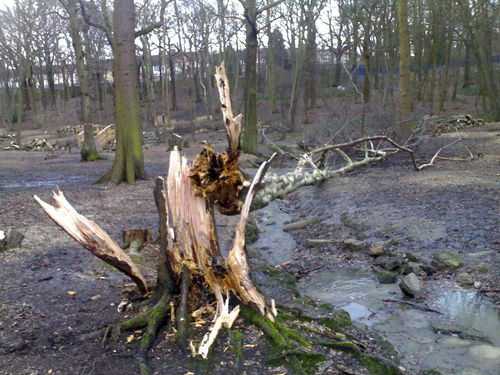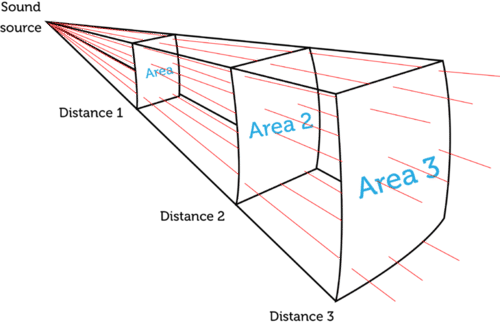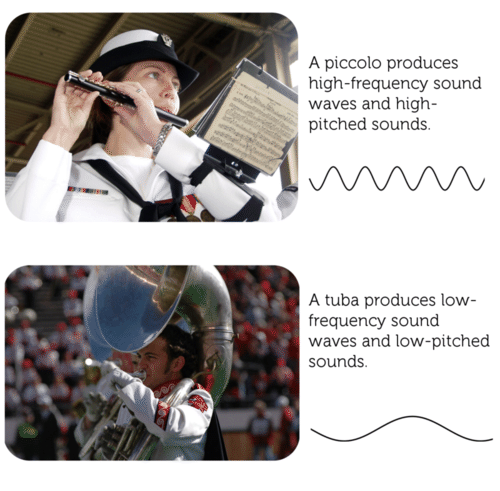1.2声音的特征
章节大纲
-
Lesson Objectives
::经验教训目标- Describe sound waves.
::描述声波
- Identify properties of sound.
::识别声音的特性。
Lesson Vocabulary
::词汇表课程- loudness
::响大
- pitch
::声道
- sound
::声音
Introduction
::导言Crack, Crackle, and Thud were the sounds the tree made when it fell to the forest floor. It fell because of the very high winds during the storm. Does it make you think of an old riddle? The riddle goes like this:
::Crack, Crackle和Thud是树落到森林地板上时发出的声音。它掉下来是因为暴风很大。它会让你想到一个老谜语吗?谜语是这样的:"If a tree falls in the forest and there’s no one there to hear it, does it make any sound?"
::"如果一棵树掉在森林里,那里没有人听到它的声音,它能发出任何声音吗?"So what do you think? Does it make a sound or not? Was there really a crack, crackle, thud to be heard?
::你觉得呢?它发出声音了吗?真的有裂缝、裂缝、颤抖的声音吗?This tree cracked and fell to the ground in a storm. Can you imagine what it sounded like when it came crashing down? What do we need to know to answer this question? You first need to know the scientific definition of sound. In science, sound is the transfer of energy. Sound energy is transferred from a vibrating object into other types of matter. Sound's energy travels through matter via waves. Typically, we think of sound waves traveling through air. Sound waves can actually travel through any type of matter, including solids and liquids. That's why we can still hear underwater.
::要回答这个问题,我们需要知道什么?你首先需要知道声音的科学定义。在科学中,声音是能量的转移。 声音是从振动物体转移到其他类型的物质。 声音的能量通过物质通过波浪流动。 典型地, 我们想到的是声波通过空气流动。 声音波实际上可以穿越任何类型的物质, 包括固体和液体。 这就是为什么我们还能听到水下的声音。Sound describes what they hear when sound waves enter their ears. The tree creates sound waves when it falls to the ground. The sound energy is transferred through the air by waves. Therefore, it makes sound according to the scientific definition. But the sound won't be detected by a person’s ears if there’s no one in the forest. So the answer to the riddle is both yes and no!
::声音描述了当声音波进入耳朵时听到的声音。 树落到地上时会产生声音波。 声音能量通过波浪通过空气转移。 因此,声音能根据科学定义发出声音。 但是,如果森林里没有人的话,一个人的耳朵不会发现声音。 所以谜语的答案是是是的,还是不是的!Sound Waves
::声波Why does a tree make sound when it crashes to the ground? How does the sound reach people’s ears? In general, how do sounds get started? How do they travel?
::为什么一棵树在坠落到地面时发出声音? 声音是如何到达人们耳朵的? 一般来说,声音是如何开始的? 它们是如何旅行的?How Sounds Begin
::声音如何开始All sounds begin when matter vibrates. It could be the ground vibrating when a tree comes crashing down. Remember that final thud? That would have been the tree hitting the ground. Sound waves can be created when guitar strings vibrate after they are plucked. You can see a guitar string vibrating in below . The vibrating string pushes against the air particles next to it. The pressure of the vibrating string causes these air particles to vibrate. The air particles in turn push together and spread apart. This starts the waves that travel through the air in all directions.
::当物质振动时, 所有的音响都会从物质振动开始。 当一棵树崩溃时, 可能是地面震动。 记得最后的震动吗 ? 这会是树撞倒地面。 当吉他琴弦被拔出后, 声波就会震动。 您可以在下面看到吉他琴弦振动。 振动弦将气粒子推向旁边。 振动弦的压力使这些空气粒子振动。 空气粒子会一起振动, 并散开。 这引发了从空中向各个方向移动的波。Plucking a guitar string makes it vibrate. The vibrating string sends sound waves through the air in all directions. Sound and Matter
::声音和物质Sound waves are mechanical waves. They can travel only through matter. They cannot travel through empty space. This was demonstrated in the 1600s by a scientist named Robert Boyle. Boyle placed a ticking clock in a sealed glass jar. The clock could be heard ticking through the air and glass of the jar. Then Boyle pumped the air out of the jar. The clock was still running, but the ticking could not be heard. That’s because the sound couldn’t travel without air particles to transfer the sound energy.
::声音波是机械波。 它们只能穿梭于物质中。 它们不能穿梭于空地中。 这在1600年代由一位名叫Robert Boyle的科学家所证明。 Boyle把一个钟钟放在一个密封的玻璃罐里。 时钟可以从罐子的空气和玻璃中听到。 然后Boyle从罐子中抽出空气。 时钟仍然在运行,但无法听到滴答。 这是因为没有空气粒子,音响无法传输声音能量。Is there any other place where sound cannot be heard? Here is a hint: is there any other place that does not have air molecules? That's right, in space sound cannot be transferred. So can astronauts hear each other? Yes, they can, because they are in enclosed space stations or pressurized suits. In both cases, they are surrounded by air molecules. If they left their space ship and did not use their electronics, they would not be able to hear each other. Next time you watch a science fiction movie, think about this factoid. When spaceships are destroyed by hostile alien beings, there would be no sound heard.
::有别的地方听不到声音吗?这里有一个提示:有没有别的地方没有空气分子?对了,空间声音是不能转移的。宇航员能听到对方的声音吗?是的,他们可以,因为他们在封闭的空间站或加压的太空服中。在这两种情况下,他们被空气分子包围。如果他们离开太空船,没有使用电子设备,他们将无法听到对方的声音。下次你看科幻电影,想想这个故事。当太空船被敌对的外星人摧毁时,就不会听到声音。Sound waves can travel through many kinds of matter. Most of the sounds we hear travel through air. Sound can also travel through liquids, such as water. They can also travel through material, such as glass and metal. If you swim underwater you still hear sound. That sound has traveled to your ears through water. You can tell that sounds travel through glass and other solids because you can hear loud outdoor sounds in your home. The sound energy, such as a siren, is transferred through closed windows and doors.
::声音波可以穿过多种物质。 我们听到的声音大多通过空气。 声音也可以通过液体, 如水。 声音也可以通过物质, 如玻璃和金属。 如果你在水下游泳, 你仍然能听到声音。 这个声音通过水传到耳朵。 你可以从家里听到声响的户外声音, 听声音从玻璃和其他固体。 声音能量, 如警报器, 可以通过封闭的窗户和门传来。Properties of Sound
::声音属性Sound has certain characteristic properties. That is because of the way sound energy travels in waves. Properties of sound include speed, loudness, and pitch.
::声音有某些特性特性。 这是因为声音能量在波浪中移动的方式。 声音的特性包括速度、 声响和投球。Speed of Sound (Advanced Topic)
::声音速度(高级专题)The speed of sound is the distance that sound waves travel in a given amount of time. You probably already know that sound travels more slowly than light. That’s why you usually see the flash of lightning before you hear the boom of thunder. However, the speed of sound can change. The speed of sound depends on the type of matter it is travelling through. Generally, sound waves travel fastest through solids.
::声音的速度是声音波在一定时间里行走的距离。 你可能已经知道声音的行走速度比光慢。 这就是为什么你通常在听到雷声的震动之前就看到闪电闪电。 但是,声音的速度可以改变。声音的速度取决于它所经历的事物的类型。 一般来说,声音波通过固体的速度最快。Imagine you are standing some distance apart from your friend. What if you had a very long stick that was held between you and your friend? You push on one end of the stick and instantly the other end moves. The stick represents sound through a solid. Sound travels more slowly through gases. That’s because the particles of solids are close together. The sound wave can quickly pass the energy to nearby particles. You can test this out by lining up dominoes and then knocking them over. If the dominoes are placed close together, the energy is passed more quickly. If they are spread farther apart, the energy moves more slowly.
::想象一下你离朋友距离很远。 如果您有一个非常长的棍子, 在您和朋友之间被紧紧地握着呢? 你推到棍子的一端, 然后立即推到另一端。 棒子代表着一个固体的声音。 声音在气体中走得比较慢。 这是因为固体的粒子很接近。 声音波可以很快地将能量传递到附近的粒子上。 您可以通过将多米诺子排成一排, 然后再击倒它们来测试这一点。 如果多米诺子被紧紧地放在一起, 能量就会更快地传递。 如果它们进一步分散, 能量就会更慢地移动。This activity will also help in understanding how temperature affects the speed of sound. For example, in air, sound has a slower speed at lower temperatures. A lower temperature means that particles are moving more slowly and are closer together. Therefore, the energy of the sound waves can be transferred more quickly.
::此活动也有助于了解温度如何影响声音速度。 例如, 在空气中, 声音在较低的温度下速度较慢。 低温意味着粒子移动较慢, 并且更接近。 因此, 声波的能量可以更快地转移 。The Table lists the speed of sound in several different media.
::表格列出了若干不同媒体声音的速度。The speed of sound depends on the medium Medium (20°C) Speed of Sound Waves (m/s) Air 343 Water 1437 Wood 3850 Glass 4540 Aluminum 6320 Loud and Soft
::高音和软音A friend whispers to you in class. You can barely hear them. To hear better you have to lean very close to hear what he’s saying. Later that day, your friend shouts to you across the football field. Now his voice is very loud. You have no problem hearing him clearly even though he’s many meters away. Obviously, sounds can vary in loudness. Loudness refers to how loud or soft a sound seems to a listener. The loudness of sound is related to the intensity of sound. Intensity is a measure of the amount of energy in sound waves. The unit of intensity is the decibel (dB) .
::一个朋友在课堂上低语你,你几乎听不到他们的声音。为了听好,你必须靠近一点,才能听到他说的话。当日晚些时候,你朋友在足球场对你们大喊大叫。现在,他的声音非常响亮。你听得很清楚,尽管他距离很远,但你听得很清楚。显然,声音在响声方面会各有不同。听者听不到的声音,声音的大声或软音。声音的响度与声音的强度有关。声音的强度是音波能量的量量。强度的单位是调音器(dB ) 。The intensity of sound waves determines the loudness of sounds, but what determines intensity? Intensity is a function of two factors. First, the amount of energy contained in the sound waves. Second, how far away you are from the source of the sound.
::声波的强度决定声音的响度, 但什么决定强度? 强度是两个因素的函数。 首先, 音波所含能量的数量。 第二, 你离声音的来源有多远 。Remember that sound waves start at a source of vibrations. Those sound waves spread out from the source in all directions. The farther the sound waves travel away from the source, the more spread out their energy becomes. This is illustrated in Figure . Even loud sounds fade away as you move further away from the source.
::记住声波始于震动源。 这些声波从源处向各个方向扩散。 声波越远远离源, 能量就越分散。 这在图中说明。 当你远离源时, 声波甚至会消失。The energy of sound waves spreads out over a greater area as the waves travel farther from the sound source. This diagram represents just a small section of the total area of sound waves spreading out from the source. Sound waves actually travel away from the source in all directions. As distance from the source increases, the area covered by the sound waves increases, lessening their intensity. Pitch
::切进A marching band is coming down the street. You can hear it coming from several blocks away. When all the instruments pass by, their unique sounds can be heard. The tiny piccolos sound like birds as they play their high notes. The big tubas rumble out their booming bass notes. Clearly, some sounds are higher or lower than others. But do you know why?
::游行乐队正从街上走来。 你可以听到它从几条街外传来。 当所有乐器经过时, 它们独特的声音都能被听到。 小型的比科洛斯象鸟一样在吹高音。 大喇叭吹出了它们跳动的低音。 显然,有些声音比其他声音高或低。 但是你知道原因吗?How high or low a sound seems to a listener is called pitch. Pitch depends on the frequency of sound waves. Recall that the frequency of waves is the number of waves that pass a fixed point in a given amount of time. High-pitched sounds, like the sounds of a piccolo, have high-frequency waves. This means they vibrate quickly. The sound of a tuba is a low frequency. The sound waves vibrate more slowly. The length of the instrument tubing is what determines the frequency.
::听者看声音看来有多高或低, 叫做声波。 pitch 取决于声波的频率。 提醒注意波浪的频率是在一定时间内通过固定点的波的频率。 高沉的声浪, 如象形波的声音, 具有高频波。 这意味着它们快速振动。 管子的声音是低频的。 声波振动得更慢。 仪表管的长度决定频率 。A piccolo and a tuba sound very different. One difference is the pitch of their sounds. Lesson Summary
::经验教训摘要- Sound is the transfer of energy from a vibrating object. The sound travels in waves through matter.
::声音是振动物体能量的转移,声音在物质中波浪移动。
- Properties of sound include speed and pitch. The speed of sound varies in different media. The pitch of sound depends on the frequency of sound waves.
::声音的属性包括速度和投放。 声音的速度在不同媒体中各不相同。 声音的大小取决于声波的频率 。
Lesson Review Questions
::经验回顾问题Recall
::回顾- How is sound defined in physics?
::物理学如何界定声音?
- Identify two factors that determine the intensity of sound.
::查明决定声音强度的两个因素。
- What is the pitch of sound?
::声音是什么声音?
Apply Concepts
::应用概念- A wind chime produces both high-pitched and low-pitched sounds. If you could see the sound waves from the wind chime, what would they look like?
::风铃产生高热和低热的声音。如果你能看到风铃的声波,它们会是什么样子?
- Explain why it is really loud next to a stereo speaker and not as loud in the next room.
::解释一下为什么音响声真正响在音响音响器旁边,而隔壁房间的音响却没有那么响。
Think Critically
::仔细仔细思考- Explain why sound tends to travel faster in solids than in liquids or gases.
::解释为什么固体中声音的移动速度往往比液体或气体中更快。
- Describe sound waves.



